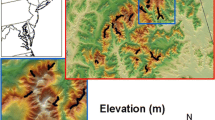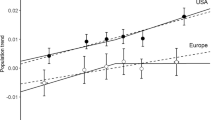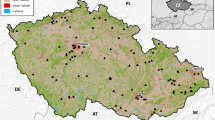Abstract
We used three approaches to assess potential effects of climate change on birds of the Northeast. First, we created distribution and abundance models for common bird species using climate, elevation, and tree species variables and modeled how bird distributions might change as habitats shift. Second, we assessed potential effects on high-elevation birds, especially Bicknell’s thrush (Catharus bicknelli), that may be particularly vulnerable to climate change, by using statistical associations between climate, spruce-fir forest vegetation and bird survey data. Last, we complemented these projections with an assessment of how habitat quality of a migratory songbird, the black-throated blue warbler (Dendroica caerulescens) might be affected by climate change. Large changes in bird communities of the Northeast are likely to result from climate change, and these changes will be most dramatic under a scenario of continued high emissions. Indeed, high-elevation bird species may currently be at the threshold of critical change with as little as 1°C warming reducing suitable habitat by more than half. Species at mid elevations are likely to experience declines in habitat quality that could affect demography. Although not all species will be affected adversely, some of the Northeast’s iconic species, such as common loon and black-capped chickadee, and some of its most abundant species, including several neotropical migrants, are projected to decline significantly in abundance under all climate change scenarios. No clear mitigation strategies are apparent, as shifts in species’ abundances and ranges will occur across all habitat types and for species with widely differing ecologies.




Similar content being viewed by others
References
Ashton AD, Donnelly, JP, Evans, RL (2007) A discussion of the potential impacts of climate change on the shorelines of the Northeastern USA. Mitig Adapt Strat (this issue)
Batzer DP, Wissinger SA (1996) Ecology of insect communities in nontidal wetlands. Annu Rev Entomol 41:75–100
Both C, Bouwhuis S, Lessells CM et al (2006) Climate change and population declines in a long-distance migratory bird. Nature 441:81–83
Botkin DB, Janak JF, Wallis JR (1972) Some ecological consequences of a computer model of forest growth. J Ecol 60:849–872
Bradley NL, Leopold AC, Ross J et al (1999) Phenological changes reflect climate changes in Wisconsin. Proc Natl Acad Sci USA 96:9701–9704
Breiman L (2001) Random forests. Mach Learn 45:5–32
Brown JL, Li SH, Bhagabati N (1999) Long-term trend toward earlier breeding in an American bird: a response to global warming? Proc Nat Acad Sci USA 96:5565–5569
Cogbill CV, White PS (1991) The latitude–elevation relationship for spruce-fir forest and treeline along the Appalachian Mountain chain. Vegetatio 94:153–175
Dale VH, Gardner RH, Deangelis DL et al (1991) Elevation-mediated effects of balsam woolly adelgid on southern Appalachian spruce-fir forests. Canad J For Res 21:1639–1648
Delworth TL, Broccoli AJ, Rosati A et al (2005) GFDL’s CM2 global coupled climate models. Part 1: Formulation and simulation characteristics. J Clim 19:643–674
Desgranges J-L, Ingram J, Drolet B et al (2006) Modelling wetland bird response to water level changes in the Lake Ontario – St. Lawrence River Hydrosystem. Env Mon Assess 113:329–365
Donovan TM, Thompson FR III, Faaborg J et al (1995) Reproductive success of migratory birds in habitat sources and sinks. Conserv Biol 9:1380–1395
Doran PJ (2003) Intraspecific spatial variation in bird abundance: patterns and processes. Dissertation. Dartmouth College, Hanover, New Hampshire
Elkins N (1988) Weather and bird behavior. T & AD Poyser, Calton
Environmental Systems Research Institute (ESRI) (2005) ArcMap GIS, ver. 9.1. Environmental Systems Research Institute, Inc., Redlands, California
Foss CR, Richards T, Evans D et al (1994) Atlas of breeding birds in New Hampshire. Chalford Publishing, Dover, New Hampshire
Galbraith H, Jones R, Park R et al (2002) Global climate change and sea level rise: potential losses of intertidal habitat for shorebirds. Waterbirds 25:173–183
Grant PR, Grant BR (1995) Predicting microevolutionary responses to directional selection on heritable variation. Evolution 49:241–251
Hale SR (2006) Using satellite imagery to model and map the distribution and abundance of Bicknell’s thrush (Catharus bicknelli). Auk 123:1038–1051
Hamburg SP, Cogbill CV (1988) Historical decline of red spruce populations and climatic warming. Nature 331:428–431
Hanski I (1992) Inferences from ecological incidence functions. Amer Nat 139:57–62
Hayhoe K, Wake C, Bradbury J et al (2007) Past and future changes in climate and hydrological indicators in the U.S. Northeast. Clim Dyn 28:381–407
Hodkinson ID (2005) Terrestrial insects along elevation gradients: species and community responses to altitude. Biol Rev 80:489–513
Holmes RT, Sherry TW (2001) Thirty-year bird population trends in an unfragmented temperate deciduous forest: importance of habitat change. Auk 118:589–610
Holmes RT, Rodenhouse NL, Sillett TS (2005) Black-throated blue warbler (Dendroica caerulescens). In: Pool A (ed) The birds of North America Online http://bna.birds.cornell.edu/BNA/account/Black-throated_Blue_Warbler/
Iverson LR, Prasad AM, Matthews S (2007) Potential changes in suitable habitat for 134 tree species in the northeastern USA. Mitig Adapt Strat (this issue)
Jacobson GL Jr, Webb T III, Grimm EC (1987) Patterns and rates of vegetation change during the deglaciation of eastern North America. In: Ruddiman WF, Wright HE Jr (eds) North America and adjacent oceans during the last deglaciation. Geol Soc Amer, Boulder, pp 277–288
Johnston RF, Selander RK (1971) Evolution in the house sparrow. II. Adaptive differentiation in North American populations. Evolution 25:1–28
Kimball KD, Weihrauch DM (2000) Alpine vegetation communities and the alpine-treeline ecotone boundary in New England as biomonitors for climate change. In: McCool SF, Cole DM, Borrie WT, O’Loughlin J (eds) USDA Forest Service Proceedings RMRS-P-15-VOL-3. Rocky Mountain Research Station, Ogden, Utah, pp 93–101
Kullman L (2001) 20th century climate warming and tree-limit rise in the southern Scandes of Sweden. Ambio 30:72–80
Lambert JD, McFarland KP (2004) Projecting effects of climate change on Bicknell’s thrush habitat in the northeastern United States. VINS Technical Report 04-2. Vermont Institute of Natural Science, Woodstock, Vermont
Lambert JD, McFarland KP, Rimmer CC et al (2005) A practical model of Bicknell’s thrush distribution in the northeastern United States. Wilson Bull 117:1–11
Laughlin SB, Kibbe DP (1985) The atlas of breeding birds of Vermont. University Press of New England, Hanover, New Hampshire
Lee TD, Barrett JP, Hartman B (2005) Elevation, substrate, and the potential for climate-induced tree migration in the White Mountains, New Hampshire, USA. Forest Ecol Manag 212:75–91
Matthews S, O’Connor RJ, Iverson LR et al (2004) Atlas of climate change effects in 150 bird species of the Eastern United States. GTR-NE-318
McPeek MA, Rodenhouse NL, Holmes RT et al (2001) A general model of site-dependent population regulation: population-level regulation without individual-level interactions. Oikos 94:417–424
Miller NG, Spear RW (1999) Late-quaternary history of the alpine flora of the New Hampshire White Mountains. Geogr Phys Quater 53:137–157
Nagy LR, Holmes RT (2005) Food limits annual fecundity of a migratory songbird: an experimental study. Ecology 86:675–681
Nakićenović N, Davidson O, Davis G et al (2000) IPCC special report on emissions scenarios. Cambridge, New York, NY
Neelin JD, Münnich M, Su H et al (2006) Tropical drying trends in global warming models and observations. PNAS 103:6110–6115
Newton I (1998) Population limitation in birds. Academic, San Diego, CA
O’Connor RJ, Jones MT, White D et al (1996) Spatial partitioning of environmental correlates of avian biodiversity in the conterminous United States. Biodivers Lett 3:97–110
Ollinger SV, Aber JD, Federer CA et al (1995) Modeling the physical and chemical climatic variables across the northeastern U.S. for a Geographic Information System. USDA Forest Service General Technical Report NE-191
Picman J (1988) Experimental study of predation on eggs of ground-nesting birds: effects of habitat and nest distribution. Condor 90:124–131
Pope VD, Gallani ML, Rowntree PR et al (2000) The impact of new physical parameterizations in the Hadley Centre climate model-HadCM3. Clim Dyn 16:123–146
Prasad AM, Iverson LR (2006) Newer classification and regression tree techniques: bagging and random forests for ecological prediction. Ecosystems 9:181–199
Pulido F, Berthold P (2004) Miroevolutionary response to climate change. Adv Ecol Res 35:151–183
Reitsma LR, Holmes RT, Sherry TW (1990) Effects of removal of red squirrels (Tamiasciurus hudsonicus) and Eastern chipmunks (Tamias striatus) on nest predation in a northern hardwoods forest: an experiment with artificial nests. Oikos 57:375–380
Rich TD, Beardmore CJ, Berlanga H et al (2004) Partners in flight North American landbird conservation plan. Cornell Lab of Ornithology, Ithaca, New York
Richardson AD, Lee X, Friedland AJ (2004) Microclimatology of treeline spruce-fir forests in mountains of the northeastern United States. Agric For Meteorol 125:53–66
Rimmer CC, McFarland KP, Ellison WG et al (2001) Bicknells thrush (Catharus bicknelli) In: Pool A (ed) The Birds of North America Online http://bna.birds.cornell.edu/BNA/account/Bicknell’s_Thrush/
Rodenhouse NL (1992) Potential effects of climatic change on migrant landbirds. Conserv Biol 6:263–272
Rodenhouse NL, Holmes RT (1992) Results of experimental and natural food reductions for breeding black-throated blue warblers. Ecology 73:357–372
Rodenhouse NL, Sherry TW, Holmes RT (1997) Site-dependent regulation of population size: a new synthesis. Ecology 78:2025–2042
Rodenhouse NL, Sillett TS, Doran PJ et al (2003) Multiple density-dependence mechanisms regulate a migratory bird population during the breeding season. Proc R Soc Lond B 270:2105–2110
Rodenhouse NL, Christenson LM, Parry D, Green LE (2007) Climate change effects on native fauna of Northeastern Forests. Can J For Res (in press)
Root T (1988) Environmental factors associated with avian distributional boundaries. J Biogeogr 15:489–505
Roth RR, Johnson RK (1993) Long-term dynamics of a wood thrush population breeding in a forest fragment. Auk 110:37–48
Saether BE, Sutherland WJ, Engen S (2004) Climate influences on avian population dynamics. Adv Ecol Res 35:186–209
Sauer JR, Hines JE, Fallon J (2001) The North American breeding bird survey, results and analysis 1966–2000. http://www.mbr-pwrc.usgs.gov/bbs
Sillett TS, Holmes RT (2002) Variation in survivorship of a migratory songbird throughout its annual cycle. J Anim Ecol 71:296–308
Sillett TS, Holmes RT (2005) Long-term demographic trends, limiting factors, and the strength of density dependence in a breeding population of a migratory songbird. In: Greenberg R, Marra PP (eds) Birds of two worlds: advances in the ecology and evolution of temperate–tropical migration systems. Johns Hopkins, Baltimore, Maryland, pp 426–436
Sillett TS, Holmes RT, Sherry TW (2000) Impacts of global climate cycle on population dynamics of a migratory songbird. Science 288:2040–2042
Spear RW (1989) Late-quaternary history of high-elevation vegetation in the White Mountains of New Hampshire. Ecol Monogr 59:125–151
Steele BB (1992) Habitat selection by breeding black-throated blue warblers at two spatial scales. Ornis Scand 23:33–42
Stireman JO III, Dyer LA, Janzen DH et al (2005) Climatic unpredictability and parasitism of caterpillars: implications for global warming. PNAS 102:17384–17387
Strode PK (2003) Implications of climate change for North American wood warblers (Parulidae). Global Change Biol 9:1137–1144
Union of Concerned Scientists (UCS) (2006) Climate change in the U.S. Northeast: a report of the Northeast Climate Impacts Assessment. UCS Publications, Cambridge, MA
US Geological Survey (1999) National elevation dataset. Earth Science Information Center, Sioux Falls
Walther G (2001) Adapted behaviour and shifting ranges of species - a result of recent climate warming. In: Walther G-R, Burga CA, Edwards PJ (eds) “Fingerprints” of climate change: adapted behaviour and shifting species ranges. Kluwer, New York, New York pp 1–7
Washington WM, Weatherly JW, Meehl GA et al (2000) Parallel climate model (PCM) control and transient simulations. Clim Dyn 16:755–774
Webb T III (1992) Past changes in vegetation and climate: lessons for the future. In: Peters RL, Lovejoy TE (eds) Global warming and biological diversity. Yale, New Haven pp 59–75
Webster MS, Marra PP, Haig SM et al (2002) Links between worlds: unraveling migratory connectivity. TREE 17:76–83
White DA, Kimmerling AJ, Overton WS (1992) Cartographic and geometric components of global sampling design for environmental monitoring. Cart Geogr Infor Sys 19:5–22
Woodward FI (1992) A review of the effects of climate on vegetation: ranges, competition, and composition. In: Peters RL, Lovejoy TE (eds) Global warming and biological diversity. Yale, New Haven, CT, pp 105–123
Yom-Tov Y, Yom-Tov S, Wright J et al (2006) Recent changes in body weight and wing length among some British passerine birds. Oikos 112:91–101
Zumeta DC, Holmes RT (1978) Habitat shift and roadside mortality of scarlet tanagers during a cold, wet New England spring. Wilson Bull 90:575–586
Acknowledgements
This work was supported by grants from Wellesley College, the US National Science Foundation to Wellesley College and Dartmouth College, the Smithsonian Institution, the Trustees and members of the Vermont Institute of Natural Science, the Thomas Marshall Foundation, Stone House Farm Fund of the Upper Valley Community Foundation, the US Fish and Wildlife Service Migratory Bird Division, and the Northern Global Change Program of the US Forest Service. We are indebted to our wonderful colleague, the late Raymond O’Connor, for all his early work in spatial assessments of bird distributions.
Author information
Authors and Affiliations
Corresponding author
Appendix
Appendix
Rights and permissions
About this article
Cite this article
Rodenhouse, N.L., Matthews, S.N., McFarland, K.P. et al. Potential effects of climate change on birds of the Northeast. Mitig Adapt Strateg Glob Change 13, 517–540 (2008). https://doi.org/10.1007/s11027-007-9126-1
Received:
Revised:
Accepted:
Published:
Issue Date:
DOI: https://doi.org/10.1007/s11027-007-9126-1




